Location-based marketing uses geographical data and mobile technology to deliver targeted, personalized messages to consumers based on their physical location. This guide defines location-based marketing, along with its benefits, examples, and future trends.
In an era where smartphones are ubiquitous and data drives decisions, location-based marketing has become a game-changer for brands.
Location-based marketing is a direct marketing strategy that involves targeting potential customers based on their geographic location using data from their mobile devices. Delivering timely and relevant ads or location-based offers to users in specific places helps businesses improve customer engagement and drive more conversions.
With almost 74% of smartphone owners using location-based services, businesses have unprecedented opportunities to reach potential customers at the right place and time. As brands strive for hyper-personalization, understanding where a customer is—and what they need at that moment—gives businesses a significant competitive advantage.
What is Location-Based Marketing?
Location-based marketing is a strategy that uses a user’s location to send tailored content and promotions to them. It uses geolocation technology to identify where users are. When users enable location services on their mobile devices, businesses can use this data to deliver targeted ads, offers, or content.
Key Components of Location-Based Marketing
- Geolocation Technology: This is the backbone of location-based advertising. By using GPS, Wi-Fi, Bluetooth, or cellular data, businesses can pinpoint users’ locations to deliver relevant messages.
- Mobile Devices: Smartphones play a crucial role in delivering location-based mobile advertising. With mobile location marketing, businesses can engage users directly via apps, push notifications, or text messages.
- Data Analytics: Analyzing location data helps businesses understand customer behaviors and preferences, enabling them to refine their strategies and create more effective location advertising campaigns.
Types of Location-Based Marketing
With the rise of mobile technology, location-based mobile marketing has become essential for businesses looking to connect with their target audiences in a more meaningful and timely manner.
Here are the different types of location-based marketing:
Geo Targeting Marketing
Geo targeting marketing involves delivering ads or content to users based on their broader geographic location, such as a city, region, or country. This form of marketing uses data like IP addresses or GPS signals to pinpoint the user’s location and serve relevant content accordingly.
Geo targeting marketing is especially effective for national or regional campaigns that aim to cater to local preferences.
Example:
A national retailer may use geo targeting advertising to promote a sale to customers in a specific city, customizing the message based on local holidays or events.
Proximity Based Marketing
Proximity-based marketing uses technologies like Bluetooth, Wi-Fi, and beacons to send messages or promotions to consumers when they are within a certain distance of a business location. It is one of the most precise forms of location-based advertising, making it ideal for real-time, in-store promotions.
Example:
A retail store might send a push notification with a discount code to a customer’s mobile device as they walk past the store, encouraging them to enter and make a purchase.
Geo Fencing
Geo fencing creates a virtual perimeter around a specific location, such as a store or event venue. When a user enters this “fenced” area, they receive targeted ads or offers on their mobile device. Geo fencing marketing is highly effective for event marketing and retail promotions.
Example:
An event organizer might use geo fencing to send exclusive directions and travel itineraries to fans as they enter the city of the venue, enhancing the event experience, and building brand loyalty.
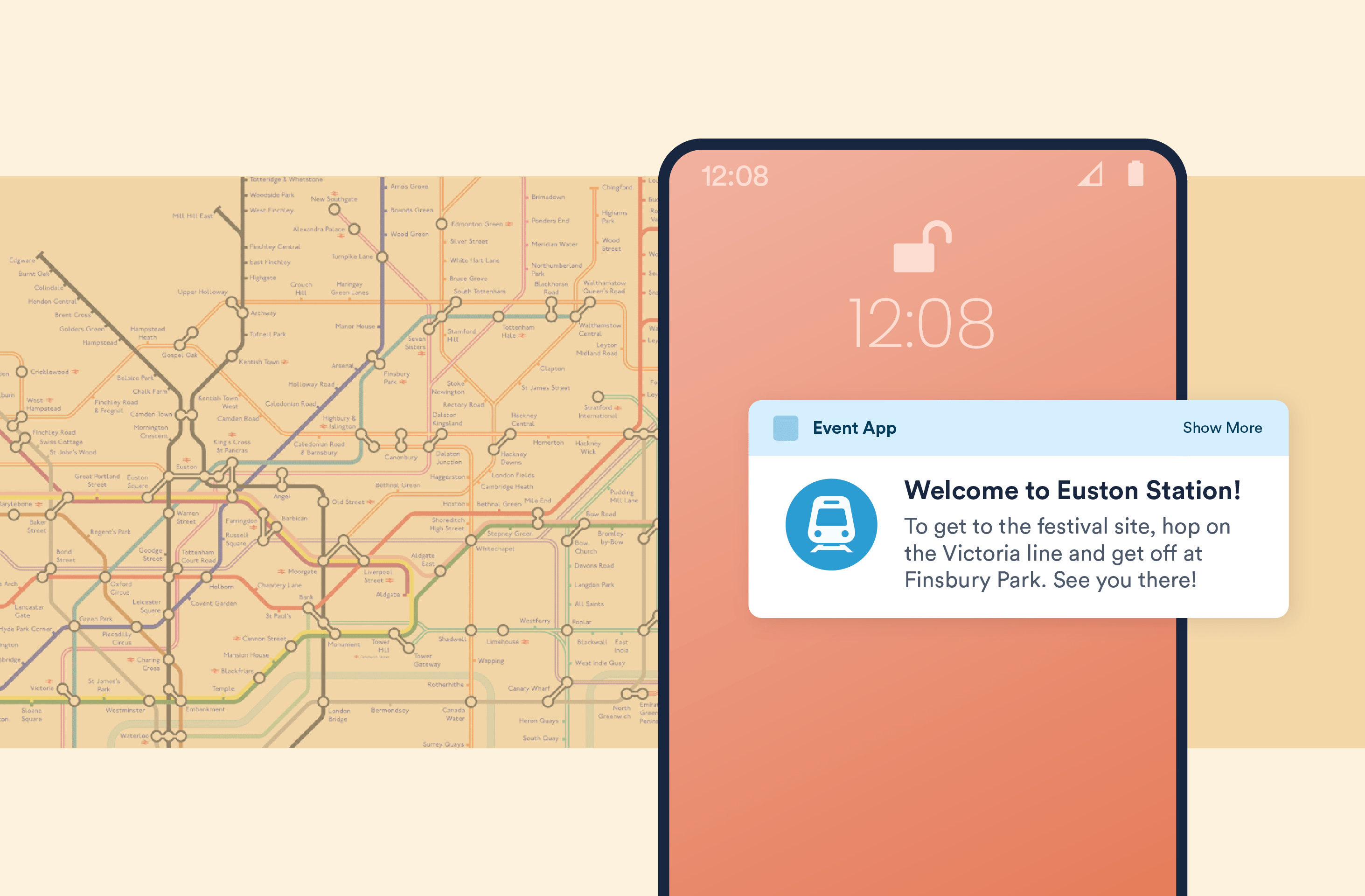
Location-Based Mobile Advertising
Location-based mobile advertising refers to serving ads to users based on their current location via mobile apps or web browsers. It allows businesses to engage users on-the-go, offering promotions or ads relevant to their current surroundings.
Example:
A food review service might use geolocation marketing to display ads for nearby restaurants to users who are traveling in a new city, encouraging them to order from local eateries.
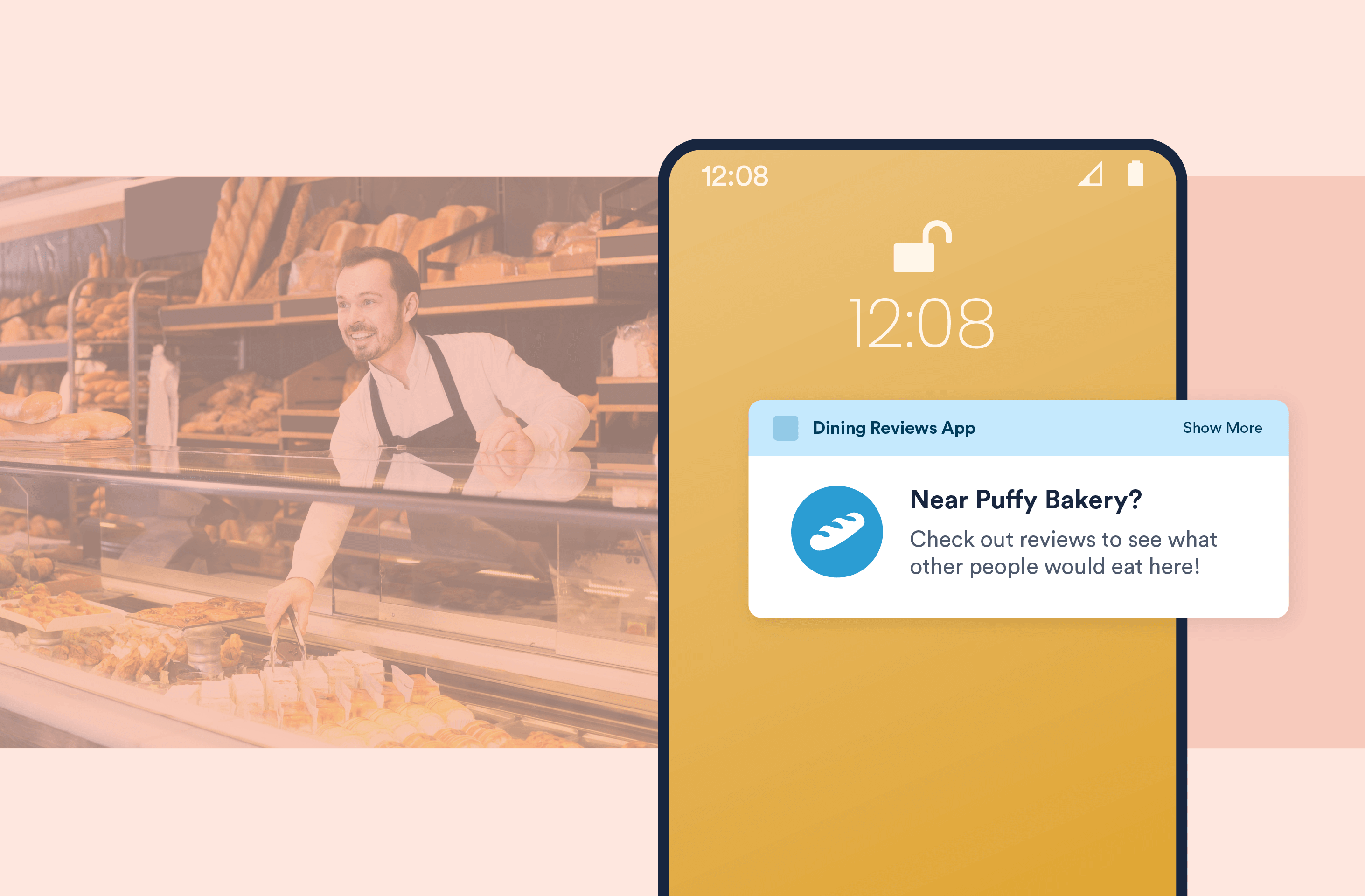
Location-Based SMS Marketing
This form of marketing sends text messages to consumers when they are in a specific location. Location-base- SMS marketing is often used for time-sensitive offers or notifications, as it guarantees direct and immediate delivery to the user.
Example:
A retail store might send an SMS alert to users offering a limited-time discount while they are shopping nearby, prompting them to visit the store.
Geo Conquesting
Geo conquesting is a competitive tactic that involves targeting consumers who are near or visiting a competitor’s location. By using geo targeting to reach these potential customers, businesses can attempt to lure them away with more attractive offers.
Example:
A fast-food chain might use geolocation marketing to send promotions to users who are near a competitor’s restaurant, offering a better deal to encourage them to choose their brand instead.
Location-Based Social Media Advertising
Platforms like Facebook and Instagram offer location-based ad targeting options that allow businesses to serve ads to users based on their geographic location. This method is particularly effective for hyper-local campaigns where businesses want to attract customers within a certain radius.
Example:
A local fitness studio might use Facebook ads to target individuals within a 10-mile radius, promoting a special offer on gym memberships.
Benefits of Location-Based Marketing with Examples
Location-based advertising offers five key advantages that can significantly impact a business’s success and prove beneficial to marketers. In this section, let’s dive into location marketing benefits and examples of location-based marketing.
1. Improving the Customer Experience
With location advertising, businesses can provide highly personalized experiences that resonate with customers. This could be sending relevant push notifications about nearby sales or offering real-time recommendations based on a customer’s location.
Here’s how location-based advertising improves customer experience.
Captures Feedback at the Right Time
Users are primed to give valuable feedback the moment their interaction with your brand comes to an end—whether that’s when their flight touches down, the credits start rolling on their movie, or they’ve just made a payment at your store.
With geolocation marketing strategies in place, send a push notification asking a short question like, “How did you enjoy your experience with us today?” Try letting users reply with an emoji for an instant emotional response that requires minimal effort. There’s no better time to engage a captive audience.
Brand examples of location-based marketing: Google Maps
As you can see in the below example, Google Maps has sent the customer a proactive prompt to rate their visit to a local establishment once they’ve detected the user has completed their interaction there, based on device location. Rather than include a form to fill out, or boxes to fill in, the star option is quick and effective. This is the time to engage with a captive audience.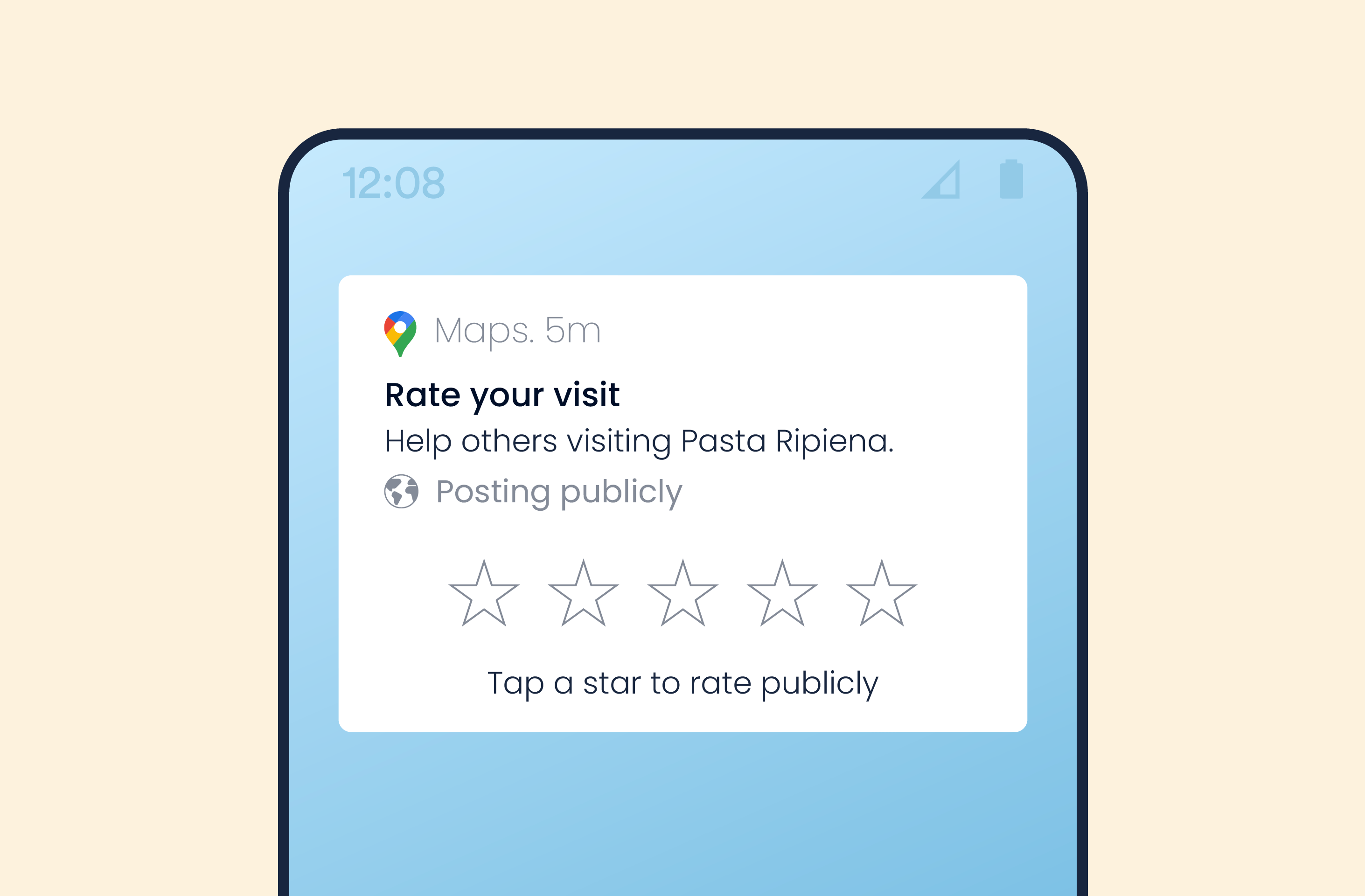
Key takeaway: Offer customers the opportunity to share how they feel at a critical moment, i.e., after they experience what your brand has to offer. Even if it’s a negative review, real-time feedback is an opportunity to understand your customers and improve their experience.
Remove Friction from User Journeys
Location-based targeting allows you to get rid of printed forms, improving the customer experience (as well as reducing your carbon footprint). By sending location-based notifications right when users leave, you become instantly more valuable to them.
For example, a health insurer may use geolocation marketing to remind a patient leaving their hospital to process their claim in the app. They don’t have to pick up the phone, wait for snail mail, or even write a check.
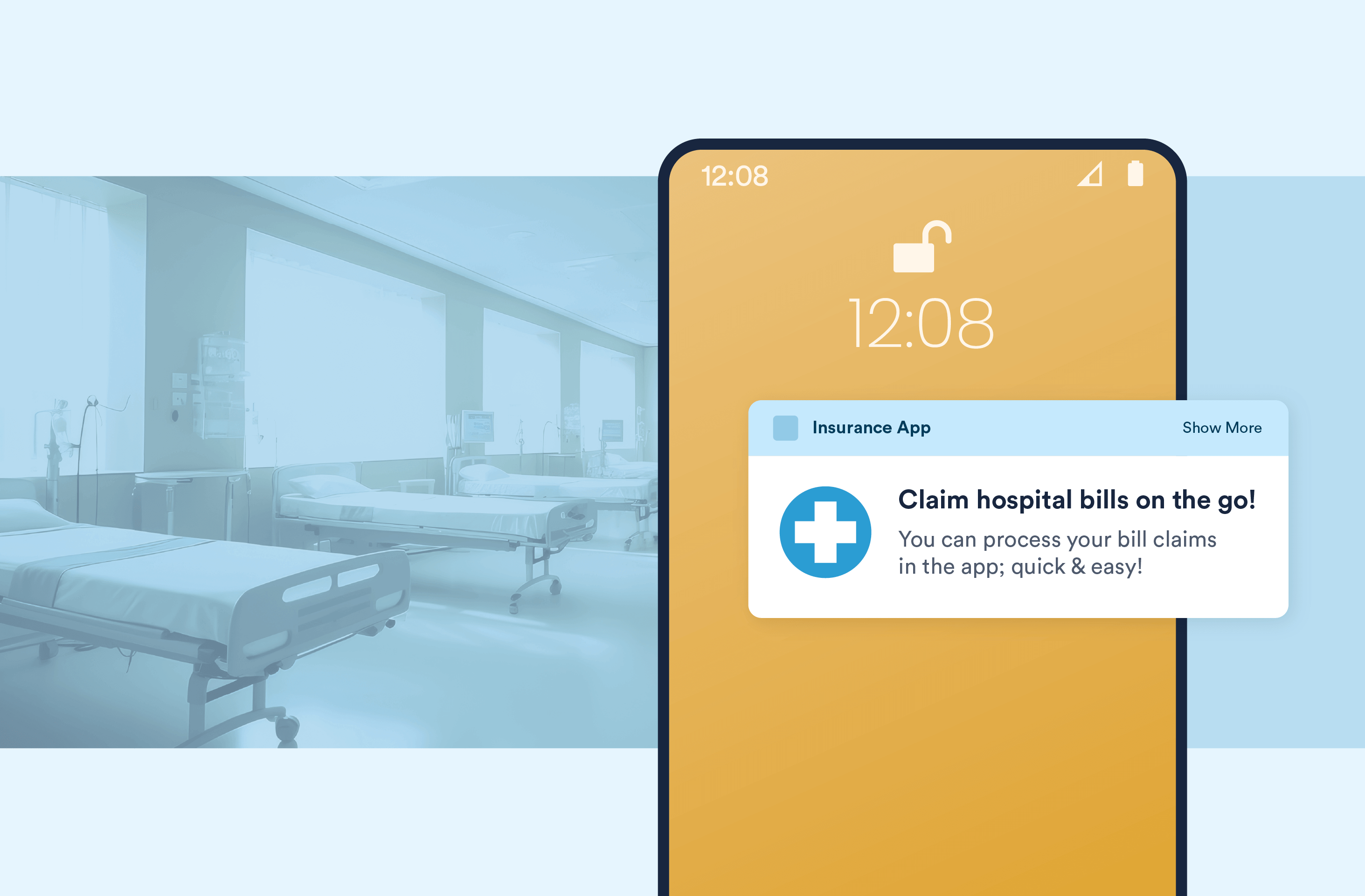
In a user journey, it’s essential that you remove any unnecessary friction and frustration for the user—if at any point branded content is irrelevant, uninteresting, or ineffective to a user, that journey is broken. This is where brands can use location-based advertising to help users find exactly what they are looking for at the moment they are looking for it.
Brand examples of location-based marketing: Yelp
Location-based advertising using a local push notification ticks two important boxes: it’s personalized and tailored to the user’s immediate preferences. This can help with short-term and long-term customer retention. If a Yelp user receives a valuable recommendation in one city, it’s likely that they’ll look to the same brand to offer up a similar recommendation on their next adventure.
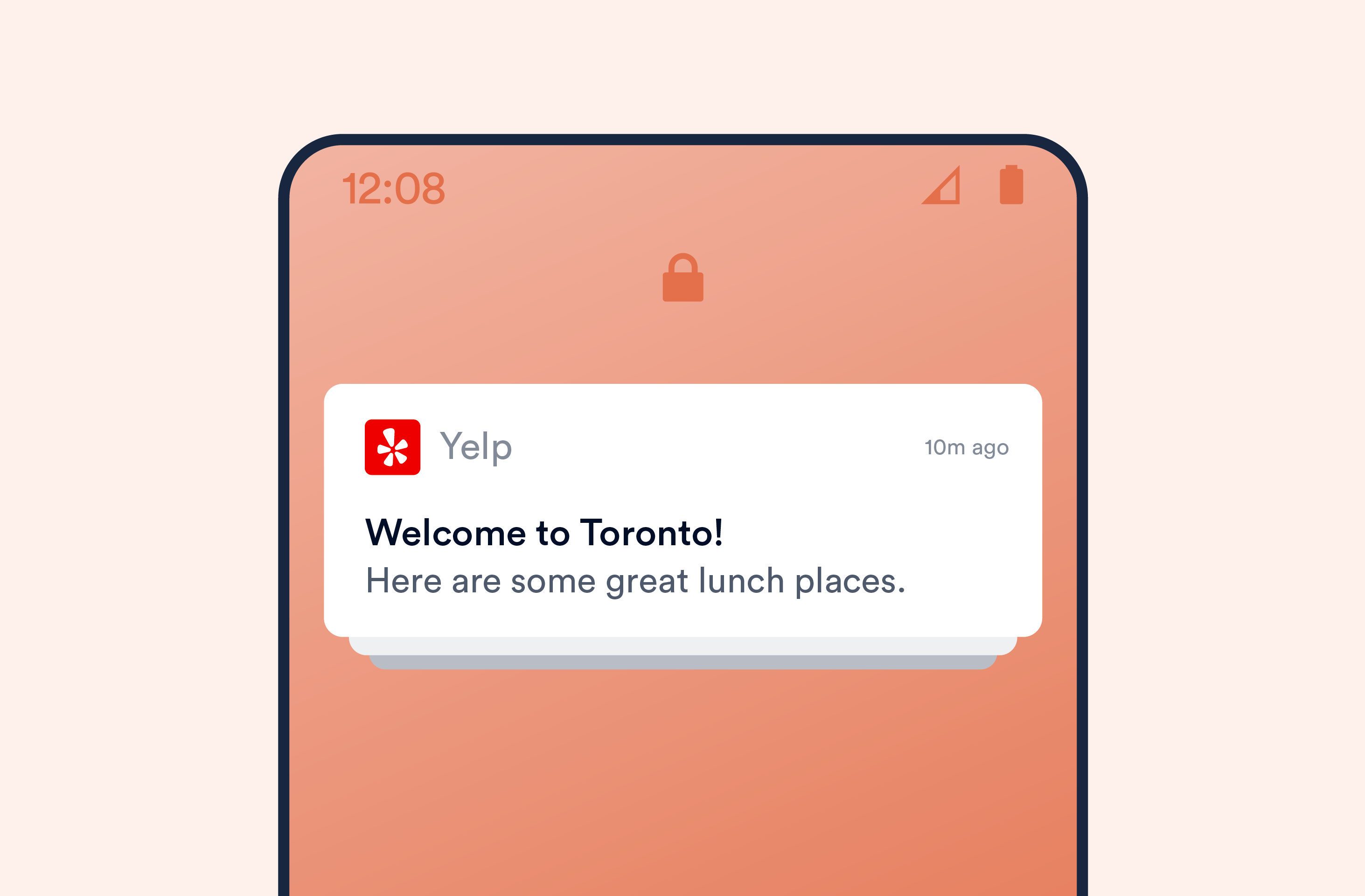
Key takeaway: Never miss an opportunity to assist a user by offering helpful resources. Map out your app’s user journey and find ways to offer value, big or small, at every step.
Steer Users in the Right Direction
Location-based mobile marketing can help you connect with local foot traffic and help crowds navigate straight toward you based on their current location.
Think of push notifications with detailed transit information when a user enters a subway station. Or information on artists and acts sent to a user upon entering a music festival. Or hyper-local offers for nearby restaurants.
Brand examples of location-based marketing: GasBuddy
In this example, GasBuddy shows value to its users through a data exchange approach. App users have the option to share their location and how much they pay for fuel. In exchange, GasBuddy reveals gas stations nearby with better deals. Geo fencing provides a myriad of opportunities to steer the right people in the right direction at the right time.
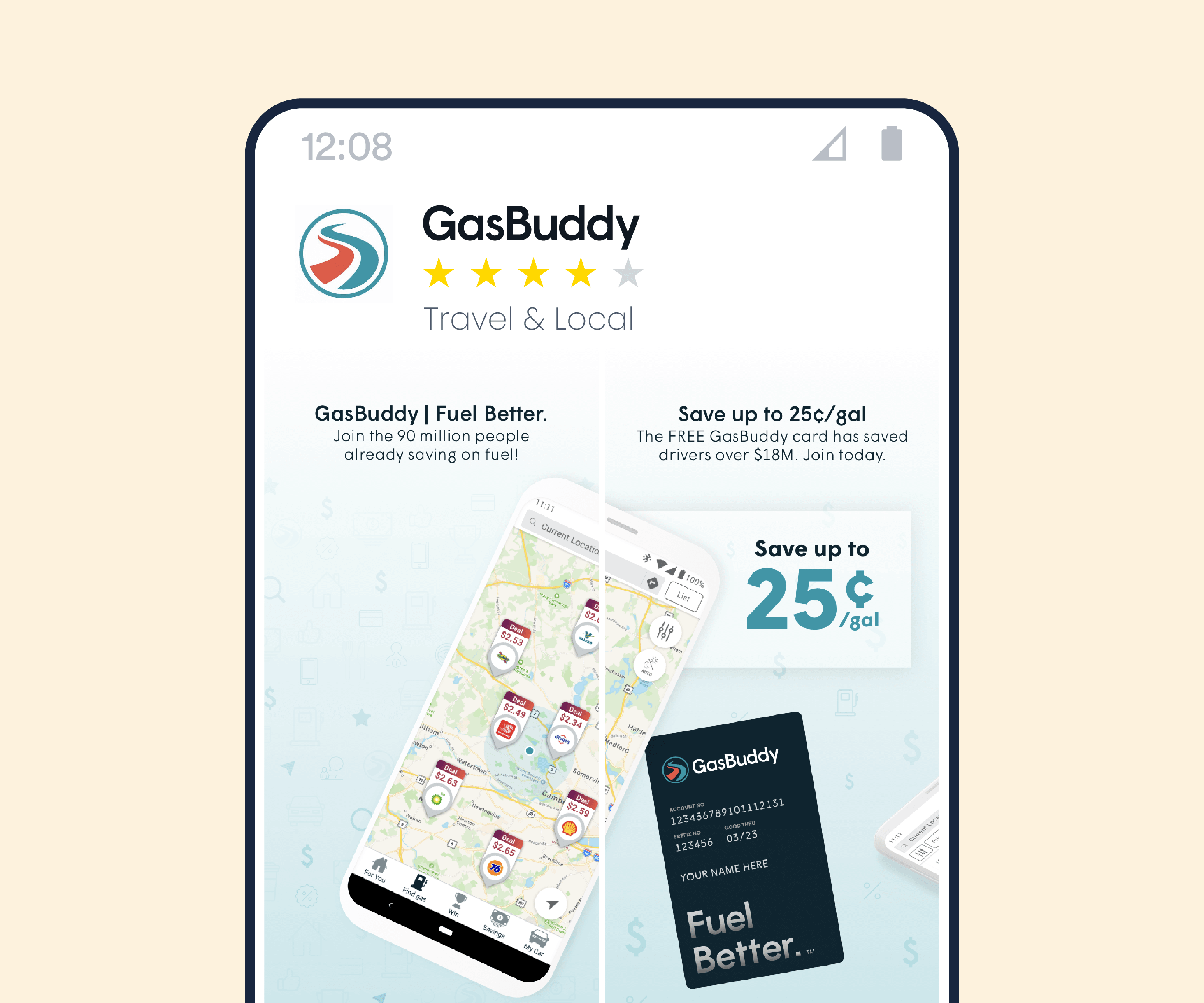
Key takeaway: Implement a valuable exchange for your users and make the most of the location-based data that is available as a result. Find out the real-time needs of your customers and guide them to a relevant solution that saves them time or money.
2. Prompting In-Store Visits
Location-based advertising excels at driving foot traffic to physical locations. Through geo fencing and proximity-based marketing, businesses can attract nearby customers with timely, location-specific promotions.
For example, a retail store might send a special 20% off coupon to customers within a one-mile radius, encouraging them to stop by.
Increase Brick-and-Mortar Traffic with Location-Based Promotions
Need to increase in-store experiences, interactions, and purchases?
Send a promotional message just as your app users pass by and entice them to visit your store. You can trigger a location-based push notification based on either granular distance from your store or physical location, so that all customers within a certain distance receive a timely, relevant offer.
Highlight convenience, tempting discounts, and the value of an in-person experience. Capture the attention of customers at a nearby restaurant to let them know your ice cream shop or wine bar is the perfect complement to their meal.
Brand examples of location-based marketing: Sephora
Who doesn’t want free stuff, especially from a popular store like Sephora? For app users within a certain radius of a nearby store, this is the type of push message that might appear. The hope is that this incentive will not only drive in-store traffic but also increase the likelihood of a full shopping cart.
This tempting offer taps into two key things: It’s concise and it highlights how an in-person experience will add value in multiple ways.
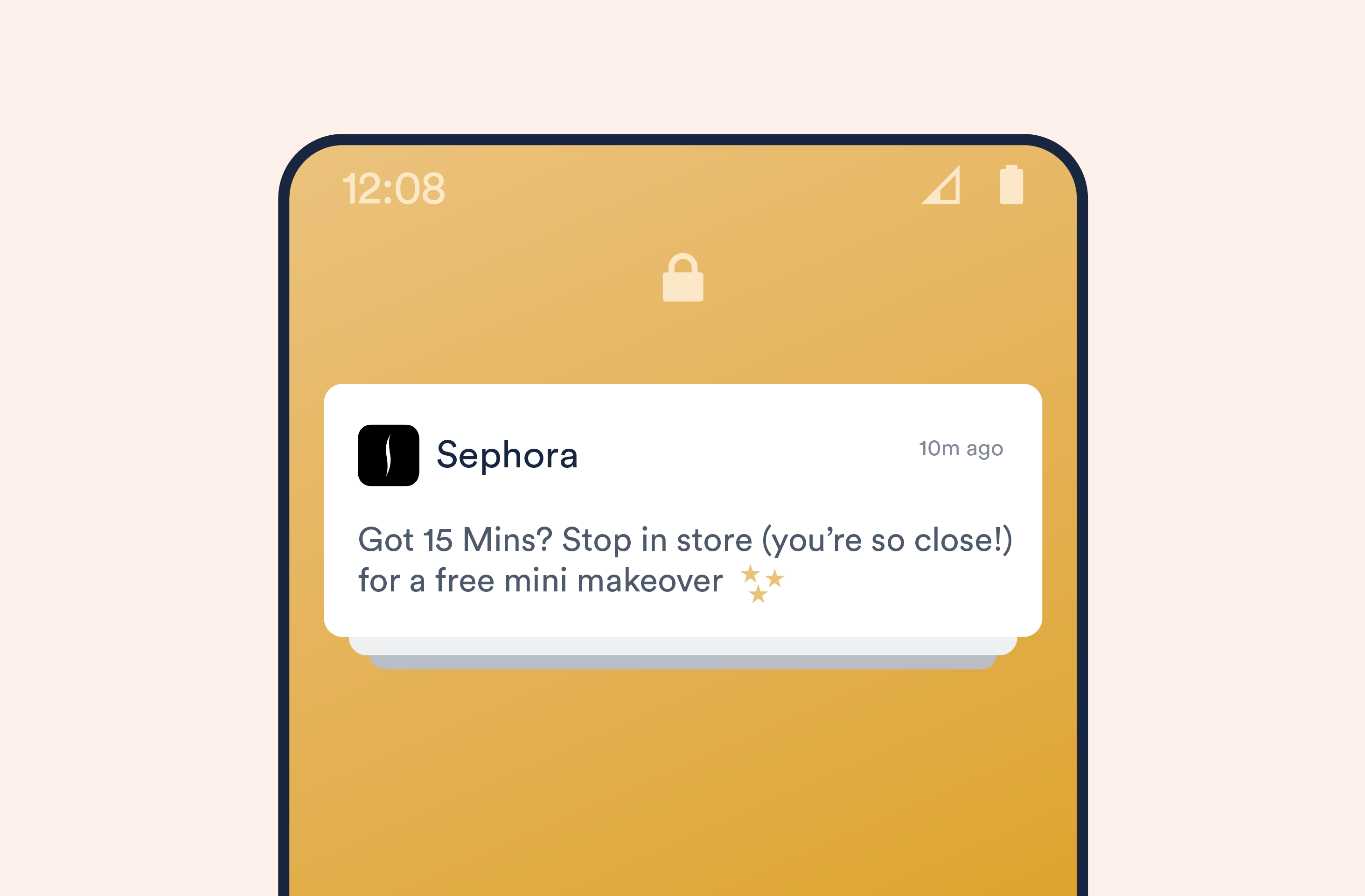
Key takeaway: Demonstrate to nearby customers the added value of an in-store visit. Highlight the convenience and the offer in a compelling, engaging way.
3. Driving Transactions
By reaching customers at the right place and time, location-based advertising significantly increases the likelihood of purchases. When customers receive relevant offers while they’re already near a store or in a shopping mindset, conversion rates typically improve. This could mean sending a limited-time offer to customers who are already in a mall or shopping district.
Upsell with Last-Minute Urgency
One of the best ways to engage app users is by meeting their needs as soon as they arise.
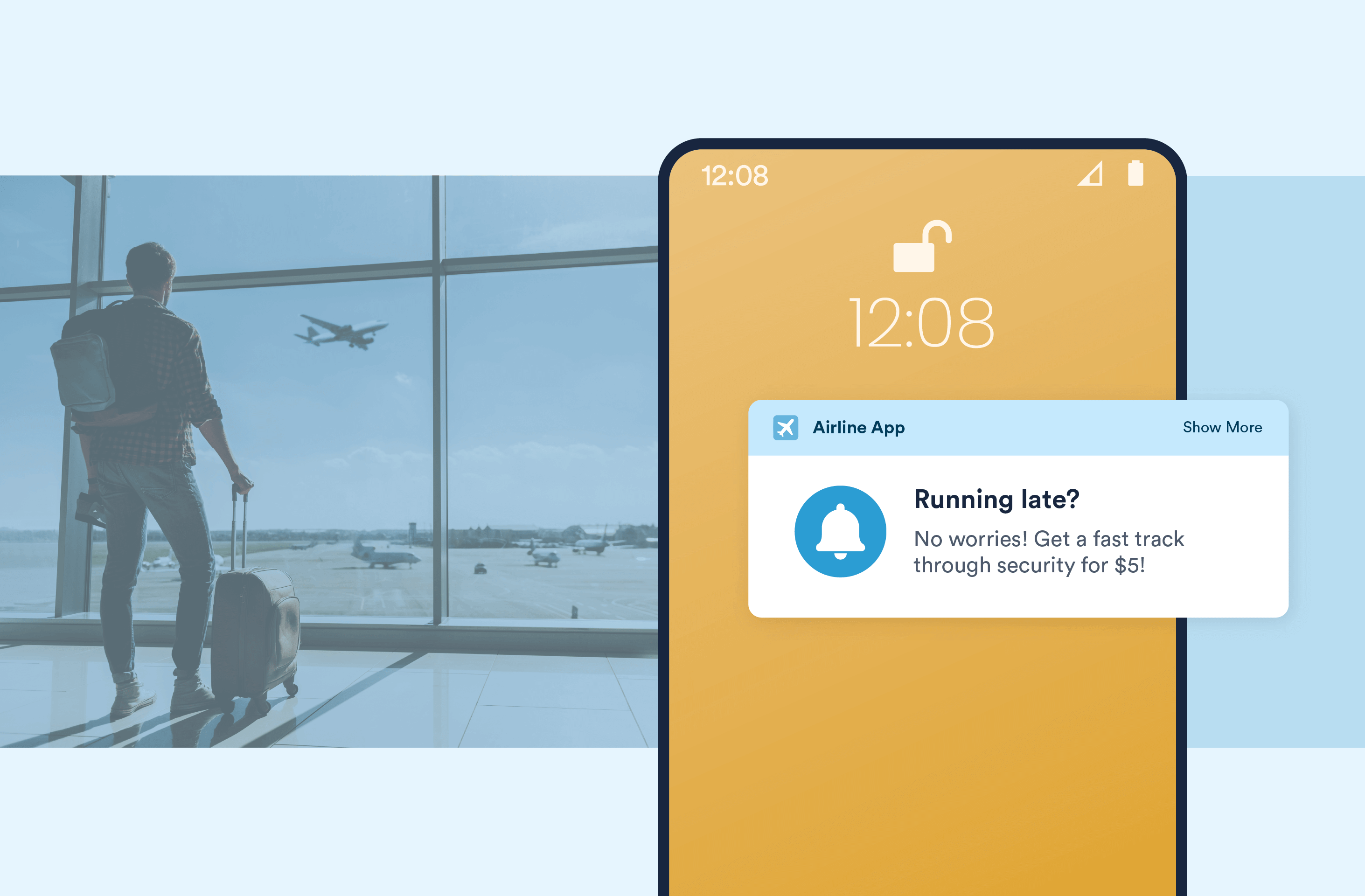
Airline passengers are a prime example: Imagine you’re running late for your flight, and as soon as you enter the airport you receive a push notification with a “skip-the-line” or quick boarding service. By making the customer’s life easier, your mobile marketing campaigns soar.
Brand examples of location-based marketing: Uber
The below example from Uber does two things well: it acknowledges an immediate need for its service and presents an urgent reminder that hesitating could run the risk of a price increase.
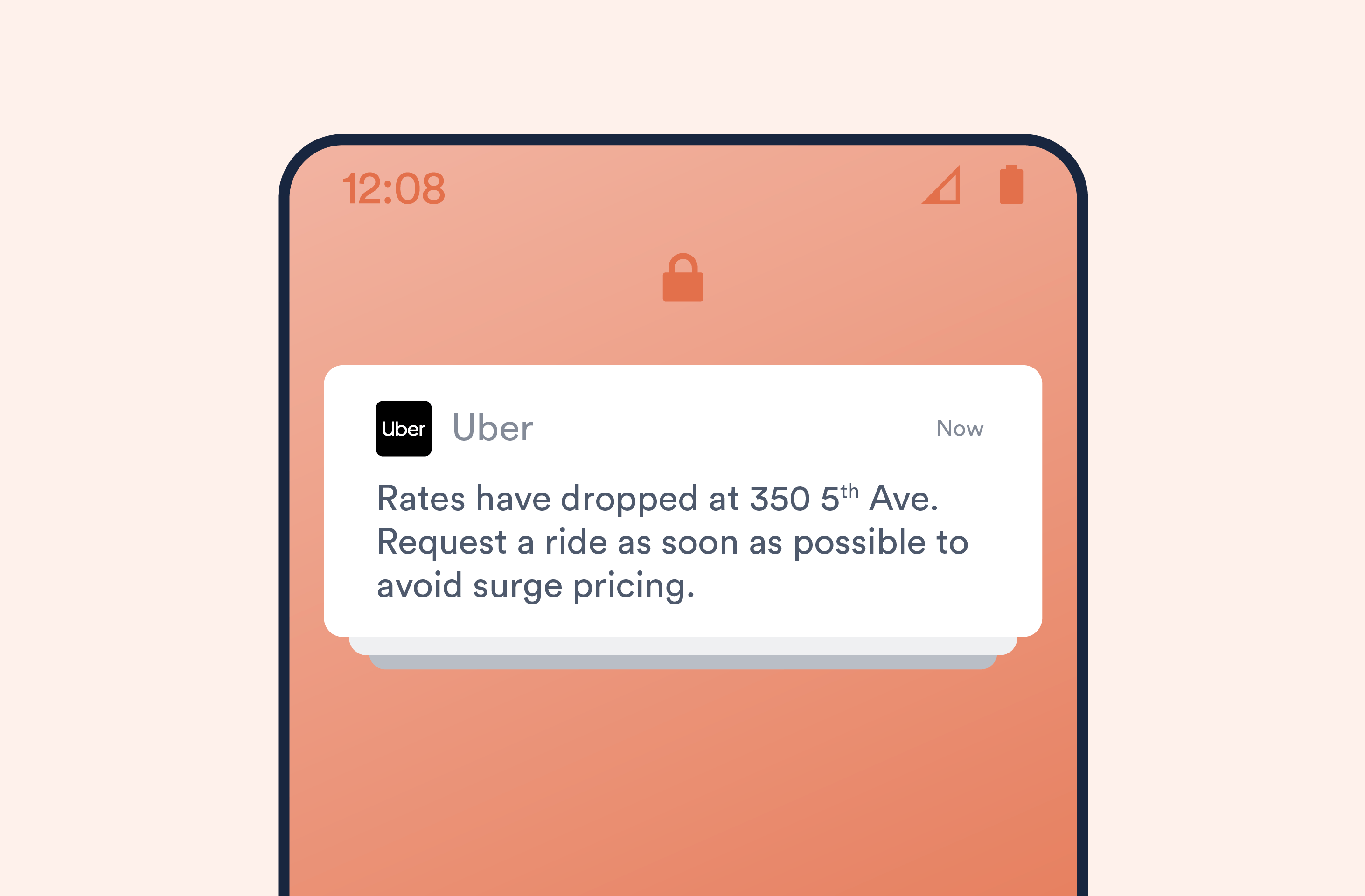
Key takeaway: Meet user needs as soon as they happen. Include relevant, urgent information in your location-based notification so a user has everything they need to make an informed transaction.
Deliver Recommendations in Real Time
Use a customer’s in-app behavior to make custom location-based offers and recommendations within your brick-and-mortar location. Send a personalized push notification referencing their online wish list or abandoned cart.
For example, “Those shoes you wanted are 50% off!” or “The headphones you liked are back in stock!” or “There’s a flash sale on team merchandise for all fans in Section A!”
Whatever trigger works for your brand, make it work for users in real time.
4. Improving Audience Targeting
Location data provides valuable insights into customer behavior and preferences, enabling more precise targeting. Businesses can analyze patterns in customer movement and shopping habits to create more effective marketing campaigns and better segment their audience. This results in more efficient ad spend and higher ROI on marketing efforts.
Remember those customers dining in the nearby restaurant? Next time they’re in the area, why not recommend a similar dining experience? Enriching these real-world customer journeys with real-time recommendations has never been easier.
Here’s where the cycle of customer experience is completed: by closing the loop via retargeting.
With a broader ecosystem of touchpoints, beginning with location intelligence for optimum accuracy, you can start with an immediate one-to-one conversation to build trust—and scale across email, social, display, onsite personalization, and beyond.
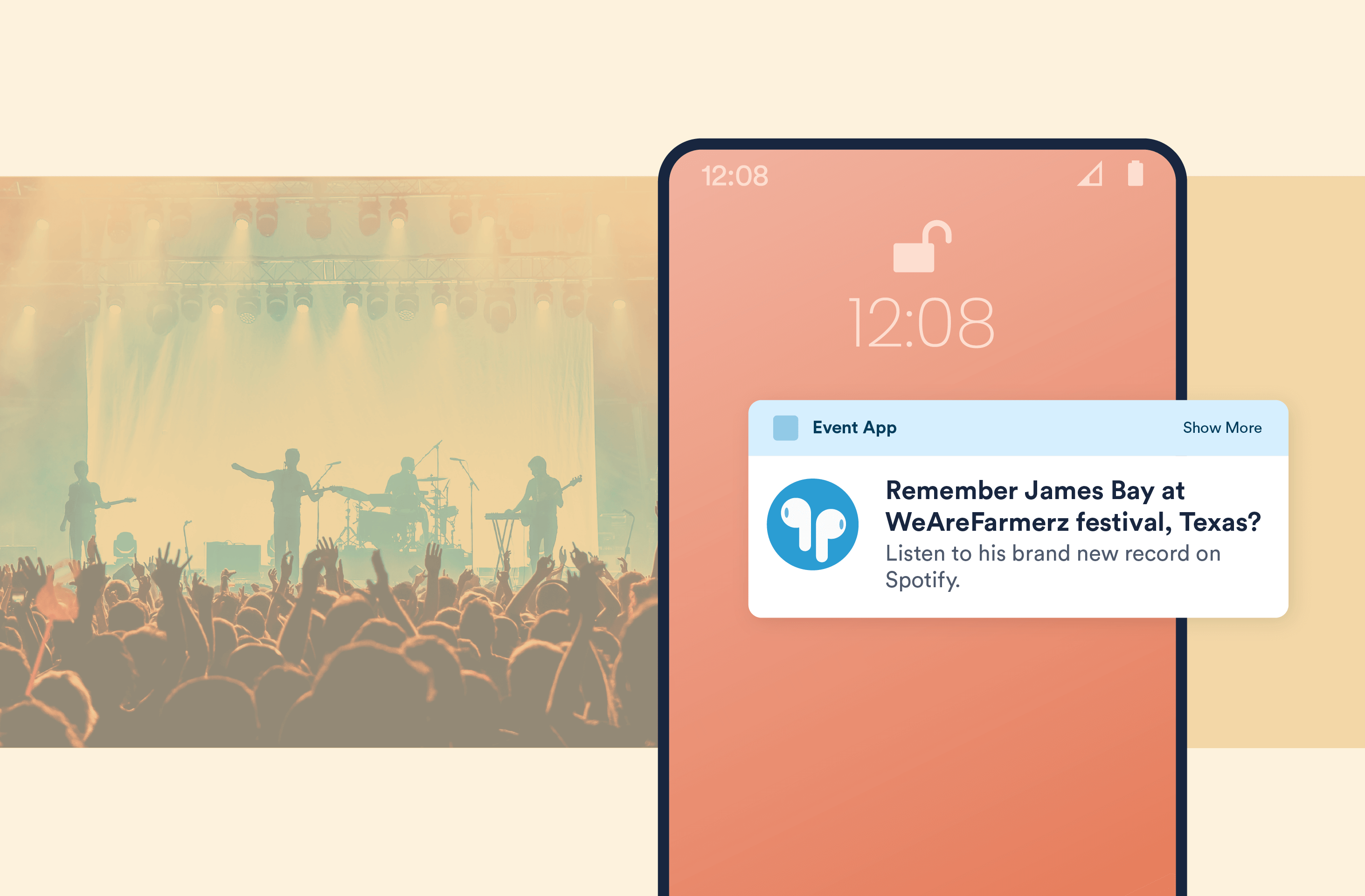
5. Bridge Online and Offline Touchpoints
The number of customer touchpoints is vast. From location intelligence for accuracy, you can move to a scaled approach of targeting across email, social media, and mobile. Capitalize on this momentum by creating a bridge between online and offline moments.
Brand examples of location-based marketing: Ticketmaster
Event apps are a prime example of brands looking to bridge offline and online moments.
If a user enjoyed their time at your concert, festival, or event, it’s likely that they’ll be interested in new music from the bands involved. That’s where this Ticketmaster example works. It reminds the user about the great experience they had at the festival (offline) while also connecting them with valuable information in the present, like a Spotify playlist (online).
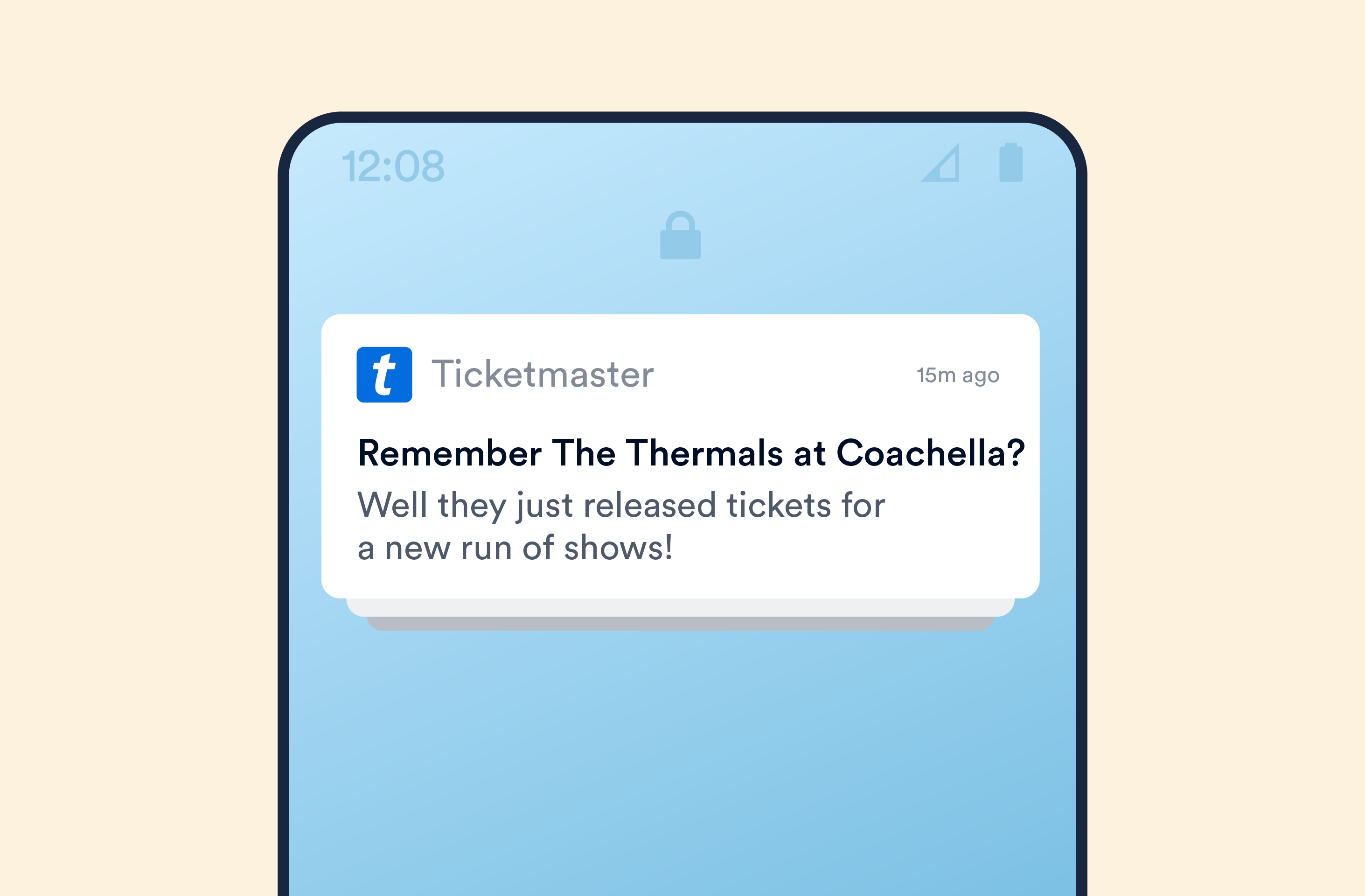
Key takeaway: Identify ways to connect online and offline experiences. Remind users about the value that both moments bring to their past and present needs.
Location-Based Marketing Examples Across Industries
Location-based advertising campaigns are useful across all industries. Here are some examples:
- Retail Sector: Many retailers use location-based marketing examples to increase foot traffic. For instance, Starbucks uses location-based mobile advertising to send promotions when customers are near one of their stores, encouraging them to stop by for a coffee.
- Restaurant Industry: Restaurants often rely on proximity-based marketing to attract nearby customers. Burger King, for example, used geo targeting advertising in its “Whopper Detour” campaign, offering users a discounted Whopper if they ordered it while near a McDonald’s.
- Travel and Tourism: Travel companies often use geo-location marketing examples to provide targeted offers to tourists. Hotels and airlines might offer promotions to users who arrive in specific cities or regions, leveraging geo based marketing to drive bookings.
- Entertainment and Events: Concert venues and event organizers often use location advertising to engage attendees before, during, and after events. Coachella, for example, uses place-based advertising examples to offer exclusive promotions to festival-goers.
Best Practices for Implementing Location-Based Marketing

- Set Clear Objectives: A successful location marketing strategy should start with clear objectives. Whether you aim to increase foot traffic or drive mobile engagement, define your goals upfront to guide your tactics.
- Respect User Privacy: Always obtain consent before collecting data for location marketing. Transparency is key to maintaining trust with your audience, especially in location targeted advertising.
- Ensure Relevance and Value: When you do geo targeting advertising, don’t just push ads based on location. Ensure the content you deliver is relevant and provides value to the user, whether through promotion, helpful information, or a personalized recommendation.
- Integrate with Overall Marketing Efforts: Location marketing shouldn’t be siloed. Integrate it with your broader digital and offline campaigns to maximize its effectiveness.
Future Trends in Location-Based Marketing
- Emerging Technologies: Innovations like augmented reality (AR), artificial intelligence (AI), and 5G will reshape geo location-based advertising. For example, AR could allow users to see virtual promotions as they move through a physical space.
- Predicted Developments: As technology evolves, expect location-based advertising to become even more personalized, with smarter algorithms predicting user behavior based on location data in real time.
Challenges With Location-Based Marketing
Location-based marketing faces several significant challenges in today’s digital landscape.
Privacy concerns top the list, as consumers become increasingly protective of their location data and personal information. Technical limitations, including GPS accuracy and battery drain on mobile devices, can affect campaign effectiveness and impact geo targeting advertising metrics.
Obtaining user opt-in for location tracking presents another hurdle, especially with stricter data protection regulations like GDPR and CCPA.
Additionally, businesses struggle with striking the right balance in message frequency—too many location-triggered notifications can lead to customer fatigue and opt-outs. Integrating location data across multiple marketing platforms and ensuring data accuracy remain ongoing challenges for marketers.
Build Connections With Location-Based Marketing
Hyper-targeted advertising is commonplace now. location-based marketing offers brands a way to connect with customers at the right time and place. From geo based advertising to proximity based advertising, this approach enables companies to deliver personalized, timely messages that resonate with users. As mobile technology advances and user data becomes more precise, the future of location-based advertising is brighter than ever.
Businesses that want to stay ahead should explore and implement location-based marketing strategies to enhance their customer experience, boost engagement, and ultimately drive conversions.
If you’re new to location-based marketing, this guide will help you maximize these experiences and moments at every step of the user journey. And check out CleverTap for a location based platform for marketers.
Shivkumar M 
Head Product Launches, Adoption, & Evangelism.Expert in cross channel marketing strategies & platforms.
Free Customer Engagement Guides
Join our newsletter for actionable tips and proven strategies to grow your business and engage your customers.







